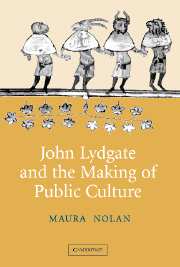Book contents
- Frontmatter
- Contents
- Acknowledgments
- Introduction: the forms of public culture
- 1 Tragic history: Lydgate's Serpent of Division
- 2 Social forms, literary contents: Lydgate's mummings
- 3 Tragedy and comedy: Lydgate's disguisings and public poetry
- 4 Spectacular culture: the Roman triumph
- Bibliography
- Index
- CAMBRIDGE STUDIES IN MEDIEVAL LITERATURE
Introduction: the forms of public culture
Published online by Cambridge University Press: 22 September 2009
- Frontmatter
- Contents
- Acknowledgments
- Introduction: the forms of public culture
- 1 Tragic history: Lydgate's Serpent of Division
- 2 Social forms, literary contents: Lydgate's mummings
- 3 Tragedy and comedy: Lydgate's disguisings and public poetry
- 4 Spectacular culture: the Roman triumph
- Bibliography
- Index
- CAMBRIDGE STUDIES IN MEDIEVAL LITERATURE
Summary
In a world governed by Fortune, kings are especially at risk. On August 31, 1422 Henry V died at Vincennes, south of Paris, at the age of thirty-five, only nine years after he had ascended to the throne. Those years had been marked by a string of military successes, culminating in the Treaty of Troyes, which established Henry as the heir to the French throne and placed France under English rule. His premature death punctured the illusion of invincibility he had perpetuated throughout his reign, reminding his subjects of the vulnerability of the great and creating a void at the very center of the realm. Henry V's legacy to his nine-month-old son was either a curse or a blessing; the years of the minority were either the finest hour of the Lancastrian regime – proof positive of its legitimacy and authority – or a prelude to the dark days of civil war and internecine strife to come. Whatever the ultimate verdict on the success or failure of the minority, it cannot be disputed that the death of Henry V produced an extreme challenge to Lancastrian authority, one that would have to be met in the arena of culture as well as politics if the reign of Henry VI was to succeed. This book begins with a very basic question: what happened to forms of cultural expression after the death of Henry V and the accession of his infant son?
- Type
- Chapter
- Information
- John Lydgate and the Making of Public Culture , pp. 1 - 32Publisher: Cambridge University PressPrint publication year: 2005



